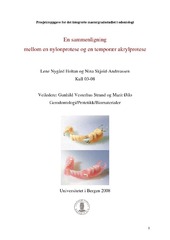En sammenligning mellom en nylonprotese og en temporær akrylprotese
Abstract
Protesematerialer i nylon markedsføres i Norge som et alternativ til tradisjonelle proteser. Da det finnes få kliniske studier om disse nye materialene, er materialegenskaper og indikasjonsområder ukjent for mange. Målet med denne prosjektoppgaven var å kartlegge dette.Det ble laget en nylonprotese og en trådklammerprotese på samme modell. Disse protesene ble vurdert in vitro med hensyn til retensjon, utstrekning, belastningsforhold, vekt og tykkelse, samt overflatens beskaffenhet. For å vurdere overflatene ble begge protesene fotografert i mikroskop.Undersøkelsene avdekket svakheter ved nylonprotesen: Nylonprotesen omslutter de marginale deler av periodontiet, noe som kan gi økt plakkaggregering. Disse protesene hadde heller ikke opplegg konstruert etter gjeldende retningslinjer, noe som kan tenkes å gi ugunstig belastning av kjevekammen.Nylonprotesen synes å retinere bedre til modellen enn trådklammerprotesen, samt var tynnere og hadde lavere vekt. Disse faktorene kan påvirke pasientkomfort.Nylonprotesen hadde glattere overflate enn trådklammerprotesene og kunne poleres like glatt etter sliping.Nylonproteser bør kun benyttes som en midlertidig løsning der man i stor grad vektlegger pasientkomfort foran potensielle biologiske skadevirkninger av protesen. Nylon as a denture-base material is being marketed in Norway as an alternative to traditional dentures. As there are few clinical trials with these new materials, many clinicians are unfamiliar with their qualities and indications. The aim of this was to evaluate available information regarding these prostheses.One nylon and one temporary acrylic denture were fabricated on the same casting. The dentures were evaluated in vitro with regard to retention, extension, load, weight and thickness and surface. The surfaces of both dentures were photographed in a microscope for comparison.The examination revealed disadvantages with the nylon denture: Nylon denture enclose the marginal periodontium, which may cause increased aggregation of bacterial plaque. The nylon denture did not have occlusal rests made after current guidelines, with possible unfavorable load to the alveolar ridge as a consequence.The nylon denture showed better retention to the model than the temporary acrylic denture. The nylon denture was thinner and weighed less. These factors may contribute to improved patient satisfaction. The surface of the nylon denture was smoother than the acrylic denture, and had the same potential for polishing.The use of nylon dentures should be restricted to temporary situations when patient comfort is more important than the possible biologic side effects.
Publisher
The University of BergenCopyright
Copyright the author. All rights reservedThe author
